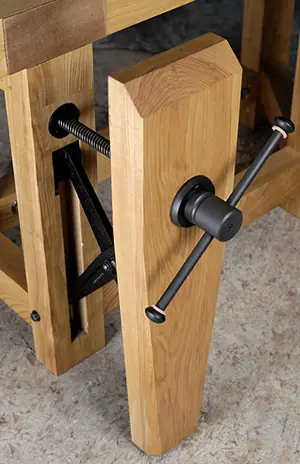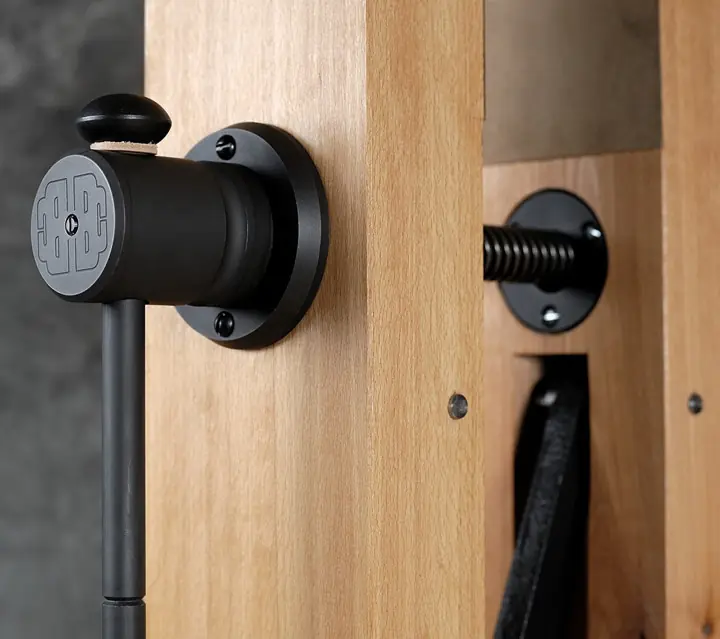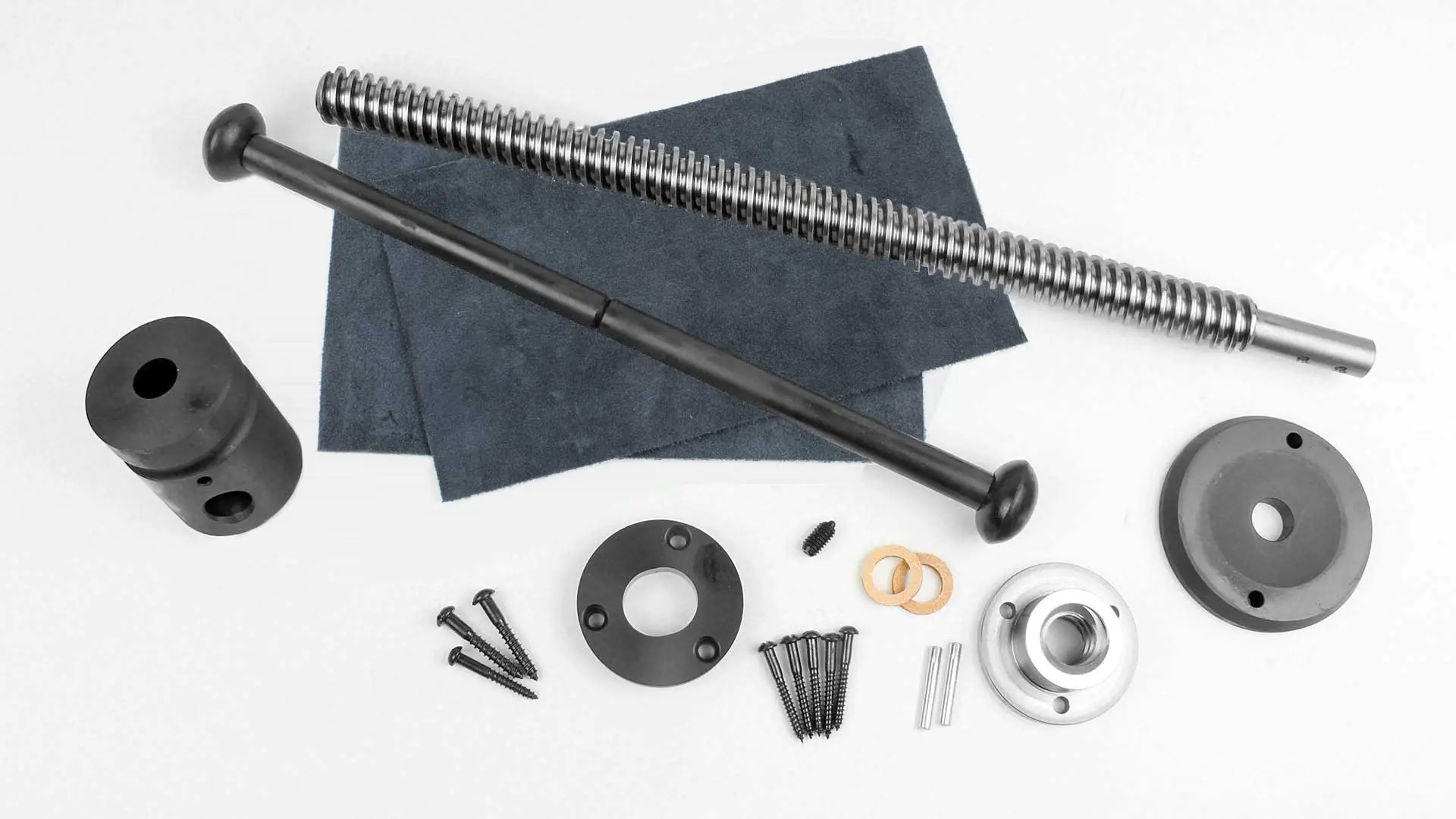Classic Leg Vise Hardware
BENCHCRAFTED

Available, delivery time: 1-3 businessdays within Germany
Product information
In the 19th and early 20th centuries, many vocational schools and professional workshops in France and its colonies were equipped with workbenches in the Roubo style. These often featured leg vises with metal fittings. The French fittings were typically entirely made of metal, while those from England and America usually had a cast iron T-piece and a movable wooden vise handle. Benchcrafted’s design is inspired by the French models. By examining the remaining historical workbenches and vises, Benchcrafted rediscovered some features and functions that modern constructions no longer possess. These and a few of Benchcrafted’s own ideas have been incorporated into the design of this workbench spindle.
Double-Threaded Screw: Most modern workbench vises use a single-threaded trapezoidal screw. Depending on the pitch used, they function either slowly and precisely with a lot of control or quickly. The spindle screw’s pitch and adjustment path should be tailored to the vise’s task. Fast adjustment isn’t always necessarily better. Manufacturing double-threaded screws in metal is expensive and risky, as large amounts of material need to be removed.
Front vises are usually used in a relatively small clamping area. However, if you need to open them wide, it’s advantageous if you can move them quickly and easily. This can be achieved either through ergonomics—like the heavy handwheels of the Glide series—or through speed—like the Classic spindle, which has a double-threaded trapezoidal screw. The Classic spindle moves as quickly as a typical wooden spindle, i.e., 12.7 mm (1/2 inch) per revolution.
Convex Hub and Matching Flange: The contact surfaces of the hub and flange have a radius of 127 mm (5 inches). This allows the parts to easily interlock and distribute the clamping pressure over a larger surface, even when clamping workpieces that are not entirely parallel.
Balanced Vise Handle: The movable vise handle has a V-shaped groove in the middle. A spring-loaded pin, located in the center of the hub, locks into this groove. This allows you to quickly balance the vise handle to rapidly turn the spindle for coarse adjustment of the vise. You can usually leave the handle centered during and after clamping the workpiece. The spring tension on the pin is adjustable. Higher tension makes it easier to find the handle’s center position but slightly hinders its free movement. There is a middle setting that allows the handle to be easily centered and quickly moved. You can also completely disable the pin if desired. The spring-loaded pin also allows you to always position the vise handle so that it does not interfere with you or the workpiece. The leather stop discs further refine the handle’s function.
Manganese Phosphate Coating: The spindle set is made of steel. However, Benchcrafted wanted it to look as if it had the typical patina of forged iron. To achieve this without exceeding the budget, the handle, hub, and flange are phosphated. Manganese phosphating is a surface treatment often used on hunting rifles. It darkens the raw steel surface, which is first sandblasted. The treatment simultaneously provides higher abrasion resistance and better sliding properties. The process is more expensive than other alternatives but offers an attractive gray-black matte finish with very high durability. If you work the surface with fine steel wool and then treat it with some thin oil, you achieve not only a beautiful classic appearance but also good sliding properties and excellent corrosion protection. More details can be found in the instructions.
The Crisscross: The Classic spindle is optimally suited for use with Benchcrafted’s crisscross. The crisscross can easily support the weight of the spindle and a wooden jaw. Additionally, using Benchcrafted’s crisscross eliminates the need to use another parallel guide and adjust it to the workpiece. When properly adjusted, the spindle works almost friction-free with the crisscross.
Angled Leg Vises: Both Benchcrafted’s crisscross and spindle can also be used for angled leg vises, as found on some historical English-style workbenches. However, when installed at an angle, the forces no longer act vertically on the crisscross, so it doesn’t run completely friction-free. The vise can still be opened and closed easily, just not as easily as with vertical installation. Benchcrafted recommends not angling the vise more than 15° when using the crisscross.
Weight: 4.3 kg
Contents of the spindle set (image):
- 1 Hub
- 1 Flange
- 1 Spindle
- 1 Complete vise handle (one shaft and two end caps)
- 1 Spindle nut
- 1 3/16 inch x 1-1/4 inch dowel pin
- 1 Plastic bushing
- 2 #12 × 1-1/2 inch round head wood screws (for the flange)
- 3 #9 × 1-1/2 inch round head wood screws (for the spindle nut)
- 3 #9 × 1-1/2 inch round head wood screws (for the plastic bushing)
- 1 Spring-loaded pin
- 2 Leather discs
- 2 Pieces of leather or crubber (mixture of cork and rubber) approx. 230 × 130 × 2 mm as jaw pads for gentle and firm clamping
Additional links / downloads
Login




